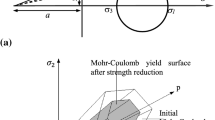Abstract
In the traditional strength reduction method, the cohesion and the friction angle adopt the same reduction parameter, resulting in equivalent proportional reduction. This method does not consider the different effects of the cohesion and friction angle on the stability of the same slope and is defective to some extent. Regarding this defect, a strength reduction method based on double reduction parameters, which adopts different reduction parameters, is proposed. The core of the double-parameter reduction method is the matching reduction principle of the slope with different angles. This principle is represented by the ratio of the reduction parameter of the cohesion to that of the friction angle, described as η. With the increase in the slope angle, η increases; in particular, when the slope angle is 45°, η is 1.0. Through the matching reduction principle, different safety margin factors can be calculated for the cohesion and friction angle. In combination with these two safety margin factors, a formula for calculating the overall safety factor of the slope is proposed, reflecting the different contributions of the cohesion and friction angle to the slope stability. Finally, it is shown that the strength reduction method based on double reduction parameters acquires a larger safety factor than the classic limit equilibrium method, but the calculation results are very close to those obtained by the limit equilibrium method.
Similar content being viewed by others
References
ZIENKIEWIEZ O C, HUMPHESON C, LEWIS R W. Assoeiated and non-associated visco-plastieity and plastieity in soil mechanics [J]. Geostechnique, 1975, 25(4): 671–689.
GRIFFITHS D V, LANE P A. Slope stability analysis by finite elements [J]. Geotechnique, 1999, 49(3): 387–403.
TAMOTSU M, KA C S. Finite element slope stability analysis by shear strength reduction technique [J]. Soils and Foundations, 1992, 32(1): 59–70.
DAWSON E M, ROTH W H, DRESCHER A. Slope stability analysis by strength reduction [J]. Geotechnique, 1999, 49(6): 835–840.
MANZARI M T, NOUR M A. Significance of dilatancy in slope stability analysis [J]. Journal of Geotechnical and Geoenviromental Engineering, ASCE, 2000, 126(1): 75–80.
ZHAO Shang-yi, ZHENG Ying-ren, ZHANG Yu-fang. Study on slope failure criterion in strength reduction finite element method [J]. Rock and Soil Mechanics, 2005, 26(2): 332–336. (in Chinese)
ZHANG Lu-yu, ZHENG Ying-ren, ZhAO Shang-yi, SHI Wei-ming. The feasibility study of strength reduction method with FEM for calculating factors of soil slope stability [J]. Journal of Hydraulic Engineering, 2003, (1): 21–27. (in Chinese)
WU Li-jun. Research of relevant issues and engineering application of finite element strength reduction method [D]. Changsha: Central South University, 2009. (in Chinese)
ZHENG Hong, SUN Guan-hua, LIU De-fu. A practical procedure for searching critical slip surfaces of slopes based on the strength reduction technique [J]. Computers and Geotechnics, 2009, 36: 1–5.
CHENG Y M., LANSIVAARA T, WEI W B. Two-dimensional slope stability analysis by limit equilibrium and strength reduction methods [J]. Computers and Geotechnics, 2007, 34: 137–150.
WEI W B, CHENG Y M. Soil nailed slope by strength reduction and limit equilibrium methods [J]. Computers and Geotechnics, 2010, 37: 602–618.
WEI W B, CHENG Y M. Stability analysis of slope with water flow by strength reduction method [J]. Soil and Foundation, 2010, 50(1): 83–92.
TANG Fen, ZHENG Ying-ren, ZHAO Shang-yi. Discussion on two safety factors for progressive failure of soil slope [J]. Chinese Journal of Rock Mechanics and Engineerings, 2007, 26(7): 1402–1407. (in Chinese)
TANG Fen, ZHENG Ying-ren. Mechanism analysis on dual reduction factors about the progressive failure of slope [J]. Chinese Journal of Underground Space and Engineering, 2008, 4(3): 436–441. (in Chinese)
HONG Min-kang. Foundation soil science and soil mechanics [M]. Beijing: China Communications Press, 1979: 189–193.
LAI Guo-wei, LU Xu-yuan, CHANG Xiao-lin, HUANG Jin-song. Stability analysis of longtan RCC dam by unequal proportional reduction material strength parameters method [J]. Hydro-Science and Engineering, 2006, (2): 42–47. (in Chinese)
TANG Fen, ZHENG Ying-ren. Analysis on safety reserve of slope with two strength reduction factor [J]. Journal of Chongqing Jiaotong University: Natural Science Edition, 2007, 26(4): 95–100.
TANG Fen, ZHENG Ying-ren. Slope stability analysis based on two safety [J]. Journal of Highway and Transportation Research and Development, 2008, 25(11): 39–44.
TANG Fen, ZHENG Ying-ren. Effect on safety factors in different definitions based on strength margin [J]. Journal of Civil Architectural & Environment Engieering, 2009, 31(3): 61–65.
LIN Hang. Research of slope strength reduction method based on linear and nonlinear damage standard [D]. Changsha: Central South University, 2009. (in Chinese)
LIN Hang, CAO Pin, GONG Feng-qiang. Analysis of locations and displacement modes of monitoring points in displacement mutation criteria [J]. Chinese Journal of Rock Mechanics and Engineerings, 2007, 29(9): 1433–1438. (in Chinese)
WANG A J, CHUNG K F. Advanced finite element modeling of perforated composite beams with flexible shear connectors [J]. Engineering Structures, 2008(9): 2274–2287.
WEI, W B, CHENG, Y M. Soil nailed slope by strength reduction and limit equilibrium method [J]. Computers and Geotechnics, 2010, 37: 602–618.
Author information
Authors and Affiliations
Corresponding author
Additional information
Foundation item: Project(KZCX2-YW-T12) supported by the Chinese Academy of Science, China
Rights and permissions
About this article
Cite this article
Yuan, W., Bai, B., Li, Xc. et al. A strength reduction method based on double reduction parameters and its application. J. Cent. South Univ. 20, 2555–2562 (2013). https://doi.org/10.1007/s11771-013-1768-4
Received:
Accepted:
Published:
Issue Date:
DOI: https://doi.org/10.1007/s11771-013-1768-4




